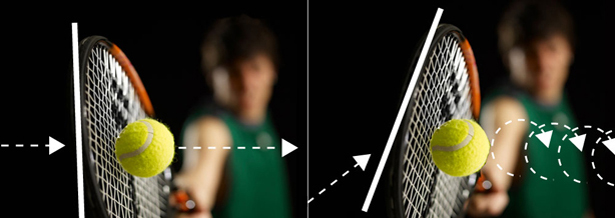Olympic Physics: Tennis

Editor’s Note: The summer Olympics draw viewers to sports that they otherwise ignore. We marvel as athletes ranging from divers to pole vaulters turn power and speed into athletic artistry. Speed (velocity) and power (force) are also key elements in physics. This is the first in a series of guest posts by Dr. Larry Silverberg, an NC State professor of mechanical and aerospace engineering, who works in the area of engineering dynamics. He talked to NC State coaches Tom Wood (track and field), Jon Choboy (tennis), and Josh Karshen (diving) about the dynamics involved in their sports. You can follow all of our Olympic posts here, as we post them.
Tennis is certainly a technical sport in terms of dynamics but it is also about strategy. Ideally, a player will incorporate his or her knowledge of the dynamics of the tennis ball into his or her strategy.
For each point, the volley begins hitting the ball mostly cross-court. It is the longest distance the ball can travel, and the goal is to force the opponent out of position. A player may put topspin (meaning the top of the ball is rotating forward) on the ball to affect the ball’s trajectory, as well as the direction of the ball when it bounces — and send the opponent further out of position. This first strategic stage is about creating opportunities. Patience and consistency are critical at this stage.
When a player sees an opportunity – when the opponent is out of position – he or she strikes. The strike tends to be as flat a shot as possible and hit with maximum effort. Since the effort to hit a ball converts into the kinetic energy of the ball (translational and rotational), by hitting a flat shot, the kinetic energy is exclusively translational motion – no energy is converted into rotational energy (spin) and the translational energy is maximized. Because all of the energy is converted into forward motion, and not spin, the ball reaches its destination in the least amount of time.
The player receiving the ball always wants his core position to be behind the ball. If his core position is far enough back, he can put more spin on the ball (if he wants to). When the ball bounces low to the ground, he may not be able to get his racket under the ball – making it impossible to apply topspin. In this case, he may need to put underspin (meaning the top of the ball is rotating backward) on the ball. This is called a slice, and can make the ball sail or float when it is traveling fast.
Olympic tennis starts July 28. (You can find more information on tennis in the Olympics here.) And, for the record, NC State fields strong tennis teams – reaching the quarter finals of the NCAA in 2007 and ranking in the top 20 last year. With new state-of-the-art tennis facilities for practice and play, NC State’s tennis program has a very promising future.
- Categories:


